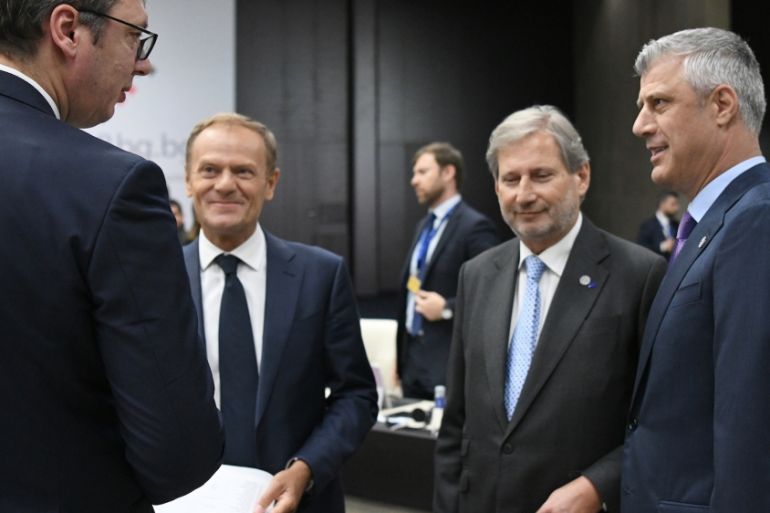Bosnia and Herzegovina is Andalusia in the making
The land swap between Kosovo and Serbia will inevitably lead to another disaster in Bosnia and Herzegovina.

Rule number one of border changes in the Western Balkans is that they are always about Bosnia and Herzegovina.
As the presidents of Kosovo and Serbia, Hashim Thaci and Aleksandar Vucic, are seeking the support of the EU for a “land swap” between their respective countries, one should keep in mind that talk of partition – because this is what it really is – of Kosovo is not about Kosovo, but about Bosnia and Herzegovina.
It is somewhat ironic that Thaci and Vucic have openly broached the issue of border changes between Kosovo and Serbia on the anniversary of another attempt to carve out Bosnia and Herzegovina.
In August 1939, the prime minister of the Kingdom of Yugoslavia, Dragisa Cvetkovic, and leading Croat politician Vladko Macek reached a deal whereby Bosnia and Herzegovina ceased to exist as a distinct political and administrative entity, with the autonomous region of Croatia annexing roughly one-third of it and the Serbian region keeping the rest. The deal is known as the Cvetkovic-Macek agreement.
When asked after World War II about the status accorded to the Muslim population of Bosnia and Herzegovina in the deal, Macek – who is lionised in present-day Croatia as a great statesman – responded: “We agreed, when it comes to Bosnia and Muslims, to regard Muslims as if they don’t exist. And that is how we acted.”
Whereas border changes in the Western Balkans were deemed unthinkable just a few years back, what is colloquially known as the international community seems now to be falling in line behind the Thaci-Vucic experiment. US National Security Adviser John Bolton stated recently that “Washington would not weigh in on an idea to swap territory between Serbia and Kosovo.”
Statements by EU Enlargement Commissioner Johannes Hahn also seem to reflect this attitude. “They need to find a solution, we will look into it with an open mind. But above all, it must contribute to regional stability and the EU path of both,” he recently said.
This change in position on land swaps in the Western Balkans basically means that the EU has decided to throw 20 years of its engagement efforts in the region out the window.
The problem is that it is doing so at a time when trouble is brewing. Whatever the details of the deal between Thaci and Vucic, part of it seems to be about Kosovo becoming a member-state of the United Nations.
But only a few weeks ago, the president of the Bosnian Serb majority entity in Bosnia and Herzegovina, Milorad Dodik, said that if Kosovo is recognised by the UN and other international institutions, Bosnian Serbs will “also seek a chair” at the UN; in other words, they will pursue independence.
This is not just empty talk. Dodik has been a Russian client for a long time. Russia, for its part, “is actively supporting indigenous political and paramilitary actors seeking to divide Bosnia and Herzegovina”, aiming to prevent the entire region from deeper integration with the West. The Russian government has been arming its police for the past few years.
Dodik openly flaunts his ideas of secession of half of Bosnia and Herzegovina (Republika Srpska plus the town of Brcko which amounts to half of the country) and regularly refers to the entity of Republika Srpska as “the second Serb state in the Balkans”.
Over the years, he has spent millions of dollars on lobbying in Washington with the aim of breaking the consensus within the US political elite on the inviolability of Bosnian borders. A “land swap” between Kosovo and Serbia would give him the precedent he needs to pursue his secessionist goals.
Bosnia’s other neighbour, Croatia, also has a stake in pushing for border changes in the Balkans. It has a history of pursuing the annexation of territories in Bosnia and Herzegovina with bloody policies.
In the 1990s, Croatia established a proxy “state” on Bosnian territory which pursued the creation of Greater Croatia through a brutal policy of mass murder, concentration camps and the systematic use of Muslims as forced labourers.
The political class in Croatia is completely unapologetic about it, as it is about the nation’s dark history of collaborating with the Nazis during World War II and aiding in the genocide of Jews, Roma and Serbian communists.
In addition, over the past several years, the Croatian society at large – abetted by senior figures in the Catholic Church – has been re-discovering its identity as a “cultural borderland”, defending Europe from an imagined “Islamic onslaught”.
Both Serbia and Croatia are intensively arming. Croatia purchased Israeli F-16s, whereas Serbia obtained Russian MiG-29s. Both the Croatian and Serbian media continuously slander Bosnian Muslims and misrepresent the country as the “ISIL heartland” of Europe.
Most recently one of the leading Serbian media outlets aired a map of the region with half of Bosnia and Herzegovina depicted as part of Serbia.
The single most important lesson of the 1990s is that there is nothing manageable about border changes in the Balkans. Attempts to change the borders have always been followed by bloodshed. By endorsing the Thaci-Vucic adventure, the EU and the US have signed off on another Balkan disaster.
Once the Kosovo precedent is set, both Serb and Croat nationalists are going to turn their gaze on Bosnia and Herzegovina and its Muslim population. In other words, Bosnia and Herzegovina and its Muslims are quickly moving from Andalusia in the waiting to Andalusia in the making.
The views expressed in this article are the author’s own and do not necessarily reflect Al Jazeera’s editorial stance.
